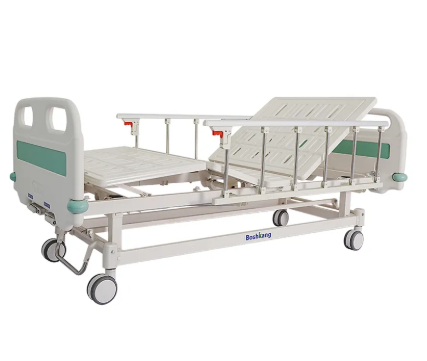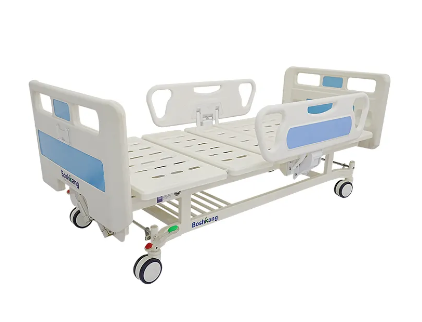Adjustable Positioning Options for Optimal Care
Height Adjustability for Safe Transfers
Adjustable height is a standard feature of nursing beds that is of great advantage to both nurses and patients. The height is also an adjustable feature, enabling the caregiver to line up the bed with a wheelchair or stretcher for easy and comfortable transfers and to minimize back strain. Studies have shown that beds with a clearance height of 24 to 30 inches are optimal for safe transfers, and offer a significantly reduced risk of falling and other injuries from patient handling. Modern nursing beds are also provided with automatic height adjustment facilities, thus promoting an efficient and safe everyday care.
Head and Foot Section Controls
Separate head and foot controls for nursing beds are needed so that a patient may be positioned to relieve discomfort of the patient. These positions are controlled so the caregiver is able to adjust positions that improve circulation, for specific medical needs (such as minimizing the risk of aspiration in certain medical conditions). Research has shown there are advantages to raising the head card – an action that can reduce the chance of aspiration. They must also be easy-to-use and user-friendly so that throughout a procedure, the caregiver can change positions to the most appropriate level of care and comfort.
Specialized Positions like Trendelenburg
Special bed positions like the Trendelenburg have additional effects besides that of a conventional tilt. This posture is optimal for enhanced venous return, and is used in few cases for emergency medicine but periodically in certain surgical procedures.. The Trendelenburg position is used to secure patients in shock by raising the feet above the head. But it is necessary to receive sufficient education as a caregiver so that his stability will not be let down, so securing skill and knowledge of the specialized position is indispensable for a proper management of the patient.
Essential Safety Features to Prevent Injuries
Bed Rails and Fall Prevention Mechanisms
Bed rails are an important factor in preventing falls in patients, especially those with mobility limitations. They create a physical separation that greatly reduces the probability of incidents, making patients safer. Studies also demonstrate that the presence of side rails that can be raised or lowered provides additional benefits through facilitation of patient transfers and enhanced patient safety. Of note, a substantial benefit in staffing is associated with decreased patient fall risk in hospitals with proper use of bed rails.
Locking Brakes and Stability Features
Hospital Beds with locking brakes Locking brakes are vital for safety, they keep the bed in place and prevent movement during use. Safely in Place – Secure bases provide safety and the feeling of confidence and prevent slipping while transferring to or from the bed. In order to keep these so-important safety things in check, healthcare establishments not just have to maintain and test them on a regular basis to fulfill the mandated requirements for safety. This alertness is important in preventing accidents and fostering a safe care enviromnment.
Emergency Alarms and CPR Functions
Alarm sounds are very important to inform the caregiver as soon as possible in an emergency alarm situation. They accelerate response times and ensure most needed care is available without undue delay. In addition, when such a nursing bed has a CPR capability, even if an emergency occurs, the bed can be rapidly and simply adjusted, enabling care givers to adjust the bed effectively and smoothly. Regular testing and maintenance of these features is essential to ensure that they will function when needed, thereby insuring patient safety and staff effectiveness.
Mattress Quality for Comfort and Pressure Relief
Anti-Decubitus and Pressure-Relief Materials
Due to the importance of pressure relief in nursing beds, the requirement for high-quality mattresses containing antidecubitus materials is essential. They are constructed for the purpose of spreading the body weight uniformly and to prevent the immobilized patients from developing pressure ulcers. For example, the pressure-relief mattresses, studies have shown, can significantly reduce pressure sores and contribute to better skin integrity and the healing of patients. This emphasis on comfort and pressure distribution highlights the importance of choosing nursing bed mattresses that meet the special requirements of at-risk patient groups.
Waterproof and Antimicrobial Covers
Nursing bed mattresses must be kept clean and hygienic, therefore waterproof and antimicrobial covering is crucial! Waterproof covers help protect the mattress from spills and bodily fluids thus help maintain the durability of the product. In addition, when it comes to healthcare products, incorporating into it antimicrobial materials can not only inhibit bacterial growth and allergens, but also provide a cleaner and healthier treatment space for patients. These covers must be kept clean and serviceable to support high standards of hygiene and provide comfortable, safe conditions for patients.
Thickness and Flexibility Considerations
The thinness and elastane of a nursing bed that is on the bed are of vital importance on how well it is able to retain comfort and support. As a general rule, thicker mattresses are also believed to better distribute pressure, which is thought to be more comfortable for the patient. At the same time, mattress flexibility ensures increased range of motion, following the path of adjustable beds. It has been reported that, for the treatment of appropriate medical condition on a patient, that optimal thickness can change from the selection of one patient to the next. Thus, knowledge of these factors is beneficial in selecting a mattress that provides the best balance between comfort and efficacy, while providing both stability and motion control for optimal patient care applications.

User-Friendly Controls and Accessibility
Manual vs. Electric Adjustment Systems
In the selection of nursing beds, it is necessary to explain the difference between the manual adjustment and electric adjustment systems. Manual systems may be cheaper but electric systems are more convenient for patients and caregivers. Powered positioning, for example, makes exact positioning more obtainable without putting physical strain on users, and means fewer caregivers will tire. Crucially, there is some evidence that indicates electric beds are associated with a higher level of user satisfaction and efficiency in care provision. This makes them ideal for patients who require to change position sufficiently, which provides patients with comfort and autonomy.
Remote Control and Voice-Activated Options
Some models also incorporate a remote control and voice activated option to make it easy to use-ifs without putting excessive physical demands on the user. Remote control technology can be wired or wireless for relaxing bed operations at 1 touch. Voice-activated options, meanwhile, are the newest technology trend, enabling the bed to be used by patients with limited movement. These enhancements are in line with the increasing emphasis on patient-focused care in healthcare systems that allows patients to easily and independently access the comfort and support they require.
Intuitive Interfaces for Caregivers
Intuitive interfaces are essential in reducing the learning curve for the caregivers so that the bed can be easily and rapidly operated during patient care. Bedside-friendly design reduces user errors in bed adjustments, directly impacting patient safety. Studies demonstrate that technology that is user-friendly also increases caregiver satisfaction, increases ease of use so that everyday processes can run more efficiently, and decreases the likelihood for error in high energy, high pressure situations. These user-friendly criteria should be well met by a nursing bed to ensure maximum accommodation of both patient as well as caregiver requirements.
Durability and Maintenance Requirements
Weight Capacity and Reinforced Frames
The load bearing of a nursing bed is an important issue related to safety and service life. It is equally important to select beds that have supported frames, which can sustain various weights of patients. Overloading a ramp can end in disaster, creating potentially dangerous situations. To ensure safety, compliance with health standard (often setting frame rules) is required. In this way, beds’ weight capacity ratings represent not only a safety perimeter for both patients and healthcare workers but also serve as a durability indicator for the bed.
Easy-to-Clean Surfaces for Hygiene
Nursing beds with washable surfaces, which are easier to clean than surfaces that are not washable, are very important for hygiene in hospitals. They are surfaces that can be easily sanitized in a short time to prevent infections due to nosocomial infections, where patient safety is an issue. FIND A STAIN-RESISTANT MATERIAL: Material that has been chosen for nursing beds should be resistant to stains and spills because they are instrumental in keeping hygiene. Daily cleaning regimens are necessary and effective in decreasing the infection risk to increase patient confidence and safety.
Compliance with Safety Standards
Conforming to safety standards is essential for the efficiency and protection of the patient that nursing beds offer. It's not only a risk to healthcare providers, there are legal consequences, but also to patients and family trust when providers are non-compliant. Beds are subject to routine audits and inspections to guarantee they are safe. Through emphasizing compliance, healthcare settings can reassure patients about the importance of safety and effectiveness which is the backbone of patient-centered care.
FAQ
What is the ideal height range for nursing beds to facilitate safe transfers?
The ideal height range for nursing beds to facilitate safe transfers is between 24-30 inches.
Why are independent controls for head and foot sections important?
Independent controls allow customization of patient positioning, helping to relieve discomfort and promote circulation.
What is the Trendelenburg position and its importance?
The Trendelenburg position elevates the feet above the head to improve venous return, critical during emergencies.
How do bed rails contribute to patient safety?
Bed rails prevent falls by providing a physical barrier, crucial for patients with mobility issues.
Why is mattress quality important in nursing beds?
Mattress quality affects comfort and pressure relief, essential for preventing pressure ulcers in immobilized patients.


